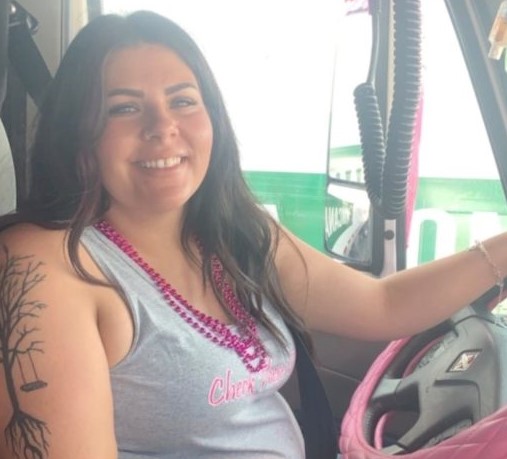Coronavirus Chronicles: Nicole Folz, Transport N Service
On April 25, professional driver Nicole Folz took her first steps in 15 days outside a makeshift Covid-19 camp at an undisclosed airport hotel in Toronto, returning home.
It capped off a wild two-week ordeal, in which Folz became trucking’s face of Covid-19, her case underscoring shortcomings in the federal and provincial governments’ preparedness, many of which have since been addressed.
Folz began feeling ill April 7 while delivering a load in South Carolina.

“It wasn’t until the following morning that I started getting worried,” she told Today’s Trucking April 23, just minutes after taking what would be her second negative Covid-19 test, following a positive result from a test taken April 10. “I had a sore throat and cough, and that’s when my fatigue from (the previous) night started to be a factor for me.”
Folz had taken all the precautions truckers and the public were advised to follow. She carried hand sanitizer in the truck and washed her hands frequently. The 26-year-old began living in the truck when the pandemic took hold, so she wouldn’t risk picking up the virus on the road and bringing it home to her parents, her sister or young niece.
“I hadn’t been going home. I was staying in my truck at the yard to keep my family safe,” Folz said.
Realizing she may have contracted the virus, Folz took additional steps to ensure the safety of others as she finished her trip. She left her paperwork in the back of the trailer for the shipper and wore a face shield. When someone reached for the gladhand on her trailer she warned them away and attached it herself.
Hearing she was unwell, her carrier Transport N Service found her a truckload for the return trip rather than her previously scheduled LTL load.
Load delivered, return load picked up, Folz’s struggles were just beginning. She blew a trailer tire in Washington, Pa., and had to engage the roadside service provider from inside the cab, having him submit the invoice by email to avoid direct contact.
Folz wondered how best to get through the border without putting Customs officers at risk.
She called Shelley Uvanile-Hesch, head of the Women’s Trucking Federation of Canada, who connected her with Transport Canada. They provided a number for a Canada Border Services Agency (CBSA) superintendent who was able to process her load in advance by email. When she approached the border, CBSA was waiting for her.
Folz was directed to a specific booth, where she held her passport against the window before being waved through. Next, the driver had to find a place to go for testing and treatment. She made more than 70 phone calls to various public health agencies looking for an answer and repeatedly got the runaround. Uvanile-Hesch called Ontario Premier Doug Ford on his cell phone on Good Friday and the wheels were immediately put into motion to get Folz help. She was given the address of the Toronto-area care center and told to report there immediately after dropping her truck at the yard.
The facility, which can’t be identified, is run by Public Health Canada and the Canadian Red Cross.
“Both parties have different things they take care of,” Folz said. “It’s been phenomenal. When I was still really sick the nurses would come to my room two to three times a day, check my temperature and my lungs, then the Red Cross would bring me meals three times a day. If I needed anything else, like prescriptions, they picked them up from the pharmacy. There’s a sanitation crew as well that comes into my room every day in full Hazmat suits and cleans the room.”
Even the food was good, she said, catered by Hockley Valley Resort. “It’s not hospital food,” she chuckled.
The virus wreaked havoc on Folz’s body. She described joint pain akin to being “hit by a train.” Her fever of more than 100 F lasted more than a week.
“I couldn’t get it to break at all,” Folz said. The first test, administered April 10, took four days to produce a result, which confirmed she was positive for Covid-19.
By April 20, rapid testing was available. Folz’s first discharge test taken April 20 returned a negative result the next day, but since the rapid tests are more prone to false negatives, she had to return a second negative test before being discharged. That was taken April 23 and just hours later produced the second negative needed to be released.
While Folz is feeling much better and is eager to be released, she’s still suffering from soreness and fatigue and doesn’t plan to return to work for another week or two.
“I am eager to get back at it,” she said. “I haven’t felt this ill for this long since I started driving. I prefer to be on the road. I love the lifestyle and I’ve very passionate about it. But I don’t think I’d last more than three hours of driving at a time right now. My body is so sore, I’m still not sleeping well because I can’t get comfortable. I go from pacing the room, to sitting on a chair, to sitting on the bed. I’m having a hard time staying in one place for too long. I plan to go home, and get my body mobile where I have more room with fresh air to walk around in.”
- Coronavirus Chronicles tell the trucking industry’s personal stories from the front lines of Covid-19. They are drawn from the ongoing coverage at www.trucknews.com.
Have your say
This is a moderated forum. Comments will no longer be published unless they are accompanied by a first and last name and a verifiable email address. (Today's Trucking will not publish or share the email address.) Profane language and content deemed to be libelous, racist, or threatening in nature will not be published under any circumstances.